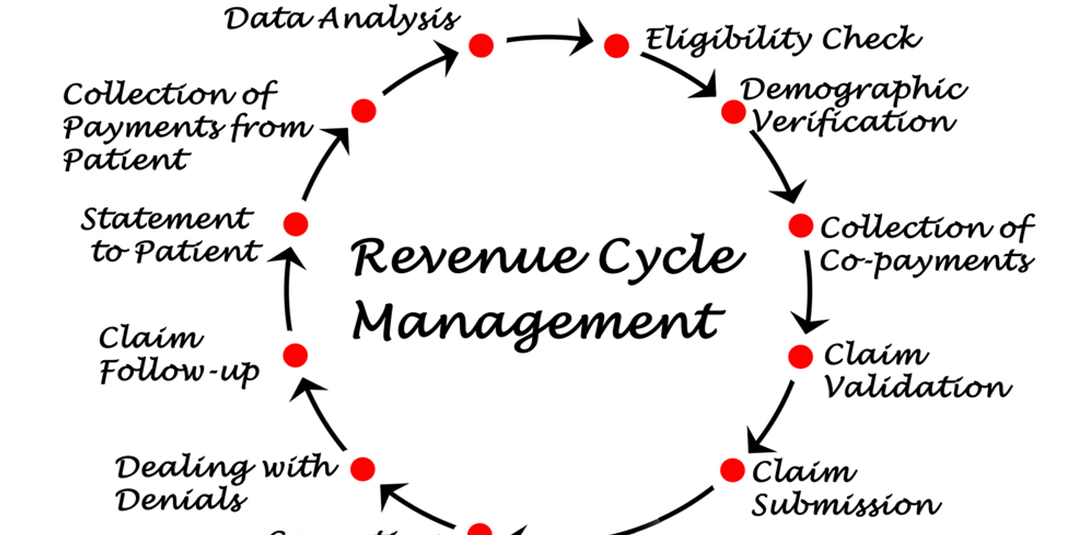- Home
- Blog Posts
-
A Guide To Healthcare Revenue Cycle Management
A Guide To Healthcare Revenue Cycle Management

Revenue cycle management (RCM) services are crucial to the financial viability of healthcare providers. By streamlining administrative tasks and patient financial interactions, RCM ensures that healthcare facilities run efficiently and are reimbursed correctly for the services they provide. In this guide, we’ll explore the essential components of healthcare revenue cycle management and its importance in today’s healthcare landscape.
Understanding Revenue Cycle Management
Revenue cycle management (RCM) is a foundational component of the healthcare industry, acting as a bridge between the clinical and business sides of healthcare. At its core, RCM manages the administrative and clinical functions related to patient service revenue. This means it’s not just about ensuring payments are made; it’s about the entire patient care experience from an administrative perspective. From the moment a patient schedules an appointment to the final payment of a bill, RCM plays a vital role.
Furthermore, an effective RCM system ensures that all processes, from patient registration and appointment scheduling to billing and collections, are seamlessly integrated. This results in improved efficiency, fewer errors, and better patient experience. The ripple effect is evident: when healthcare facilities ensure timely and correct payments for their services through efficient RCM.
The Key Stages of the Revenue Cycle
Every patient’s journey through a healthcare facility can be mapped out in various stages, each of which plays a pivotal role in revenue cycle management:
- Previsit: This is the foundational stage that sets the tone for the entire revenue cycle. Activities during this phase include scheduling the patient’s visit, verifying their insurance eligibility, and providing estimates of any out of pocket expenses. Properly handling this stage can lead to smoother subsequent stages, as the necessary data is collected and verified early on.
- Visit: The visit stage is crucial as it directly pertains to the clinical aspect of healthcare. Proper documentation during the patient’s visit ensures that the services rendered are accurately recorded, which in turn influences the billing and coding processes. A single oversight or error during this stage can lead to complications in billing, coding, and eventual reimbursement.
- Postvisit: Once the patient’s visit is concluded, the information documented is translated into medical codes, which will then form the basis of the claim to be submitted to the insurance company. This stage also involves tracking the claim, ensuring its approval, posting the payment, and diligently following up on any unpaid or denied claims.
The Importance of Accurate Coding
One of the critical stages in RCM is the coding of services. Proper coding ensures that the healthcare provider is reimbursed accurately for the services rendered. Incorrect or incomplete coding can lead to claim denials, which in turn can result in delayed or lost revenue. Moreover, accurate coding is essential to prevent issues of fraud or noncompliance, which can attract penalties.
Embracing Technology for Efficient RCM
Technological advancements have a significant impact on revenue cycle management. The integration of Electronic Health Records (EHRs) and billing software can streamline many RCM processes. For example, EHRs can provide real time patient data, aiding in accurate documentation and coding. Automated billing software can ensure timely submission of claims and track any unpaid or denied claims, enabling quicker resolutions.
Additionally, utilizing predictive analytics can provide insights into payment trends, helping healthcare providers anticipate potential challenges and adjust their strategies accordingly.
The Role of Patient Financial Engagement
In today’s healthcare landscape, there is an increasing emphasis on patient financial responsibility. With the rise of high deductible health plans, patients often bear a more significant portion of their healthcare costs. As such, healthcare providers must focus on patient financial engagement as an integral part of RCM.
This means transparent communication about costs, offering various payment options, and providing financial counseling when needed. A positive financial experience can lead to enhanced patient satisfaction, loyalty, and timely payments, thereby improving the overall RCM process.
Overcoming RCM Challenges
The path to efficient revenue cycle management is not always smooth. Healthcare providers face several challenges, from changing regulatory requirements to evolving payer provider relationships. Some of the common challenges include:
- Claim Denials: Often due to inaccurate coding or missing information, denials can significantly affect cash flow. Regular audits and reviews can help in identifying and rectifying frequent denial reasons.
- Regulatory Compliance: With the healthcare industry being highly regulated, staying compliant is critical. This requires regular training and updates for staff involved in the RCM process.
- Managing Patient Payments: As mentioned earlier, with patients shouldering more financial responsibility, managing patient payments has become more complex. Offering flexible payment plans and ensuring transparent communication can help in this regard.
Revenue cycle management is the backbone of financial operations in the healthcare sector. With the myriad challenges faced by providers, a robust and efficient RCM process is more crucial than ever.



